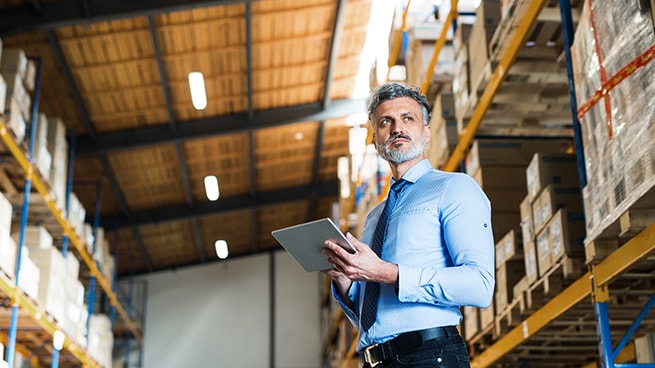While behavioural changes resulting from the COVID-19 pandemic are creating new opportunities for Canadian logistics service providers, these companies will need to up their digital game in a shifting landscape for last-mile delivery. To help you position your organization for the future of logistics, we outline a road map for your transformation journey.
A crisis is often a catalyst for long-term change. For Canadian transportation and logistics companies, a significant change already taking place is the accelerated growth of e-commerce as the COVID-19 pandemic leads consumers to shift even more of their buying habits to digital channels. This has added to the importance of quick and reliable last-mile delivery and is creating new opportunities for third-party logistics companies.
The pandemic has also put the spotlight on the importance of having strong supply chain networks, an area where third-party logistics companies play a crucial role in developing the solutions their customers will be looking for. But there are challenges as well. Third-party logistics companies are facing not just increased competition from existing and emerging players but also rising consumer expectations for delivery services. This makes it more important than ever to invest in the new technologies and digital innovations that are key to supply chain innovation and developing more advanced last-mile logistics capabilities. The good news is there are many routes to do this, whether by building digital supply chain capabilities yourself, pursuing partnerships or collaborations with innovative start-ups or a combination of both approaches. As we explore below, it all starts with setting out your vision and your strategy.
A shifting landscape for third-party logistics companies
Even before the pandemic, e-commerce was already helping to power growth for third-party logistics companies, with IBISWorld projecting 2019 revenues of CA$12.8 billion for couriers and local delivery services in Canada would rise to CA$14.3 billion by 2024. But with everything from volatile freight rates to rising input costs and sluggish trade volumes tempering the industry’s outlook, third-party logistics companies are facing several forces of change that are leading them to think differently about how they operate. But the pressures go deeper to include more fundamental changes that are challenging their business models. Let’s take a closer look at some of the forces of change:
Rising customer sophistication and expectations
With retail e-commerce sales projected to grow quickly from US$25.4 billion in 2019, clients of third-party logistics companies are increasingly looking for specialized services, like quality inspection, from their providers. And with retail e-commerce sales up 40.4% in March 2020 and 87% of Canadian Internet users having made an online purchase in the last 12 months, consumers, too, are expecting more, including:
- Faster delivery speeds, whether or not they paid for shipping
- The ability to buy, pick up and return goods anywhere
- Free or low-cost delivery
- Full order and delivery visibility
- Reduced environmental impact
- More personalized products and services that are available when and how customers want them

Consolidation and competition
The increasing consolidation and bargaining power of carriers, especially in shipping, is eroding logistics provider margins. At the same time, technology disruption is reducing entry barriers for competitors, and e-commerce platforms are increasingly investing in their logistics services and capabilities.
Accelerated, long-term shifts from the COVID-19 pandemic
As more businesses embrace e-commerce opportunities amid the COVID-19 disruption, the demand for last-mile delivery is rising to new levels. This includes many businesses, such as pharmacies, that have traditionally followed in-store purchase models but are now introducing online purchase options and deliveries to customers.
The digital supply chain opportunity for third-party logistics companies
New digital technologies are helping leading companies innovate to stay ahead of changing customer expectations. These technologies are also key to increasing efficiency through end-to-end visibility and a move toward real-time optimization. A crucial ingredient of this transformation is the connected supply chain, which lets logistics service providers offer a seamless solution to their customers. Supported and powered by advanced analytics, robotics, drones, the Internet of Things, augmented reality and blockchain, the connected supply chain can bring benefits to both third-party logistics providers and the customers they serve. The benefits of adopting digital technologies include:
- Increased responsiveness and speed as a result of automated operations, contactless handling and the use of devices like drones to optimize deliveries.
- Improved integration with retailer sales data, online transactions and social media information, which allows for better demand forecasting, capacity and operations planning and reduced inventory.
- Dynamic routing to plot the best route in real time.
- Seamless fulfillment resulting from a single view of customer demand enabled by a fully digitized, cloud-based control tower that integrates all partners involved.
- Increased supply chain nimbleness and resilience through more comprehensive proactive modelling, which is particularly helpful at times, like now, when supply chains are under pressure.
It’s important to note that while technology is crucial to embracing the emerging opportunities, there are other key elements of the transformation journey as well. To meet expectations for more delivery options, for example, third-party logistics companies can invest in alternative dropoff locations to a customer’s address, like proximity stations where they can safely leave packages and electronic mailboxes in commercial buildings and apartments. They can also integrate bikes or electric vehicles into their networks, which can help them make deliveries more efficiently in areas with traffic restrictions. And to ensure they’re exploring all opportunities to meet customer demands, they can look at the possibility of adding white-glove services, such as unboxing and assembly of goods.
Examples of uses cases for digital innovations in third-party logistics
Artificial intelligence: Route and freight optimization based on real-time environmental, traffic and vehicle data
Robotics: Robots that can sense their surroundings and assist warehouse workers
Drones: Drones are playing a bigger role in automation solutions, including when it comes to delivering medical supplies during the COVID-19 pandemic
Internet of Things: Smart sensors to determine temperature and humidity for sensitive goods
Augmented reality: Warehousing and last-mile optimization to improve loading and unloading processes and increase efficiency of order picking
Blockchain: Self-executing digital contracts to increase transparency and automate processes such as purchasing and payments
The connected supply chain
Implementing control tower functionality is an important first step to offering visibility, connectivity and integration across the supply chain. Key to this is vertical integration of demand and supply planning systems down to the execution level and horizontal integration from consumers across all of the providers in the supply chain. It’s also important to have real-time data to sense and respond to changes and use artificial intelligence to create a more predictive delivery system.
Shaping the future of logistics
As they adopt new innovations to rise to these challenges, third-party logistics companies are closely eyeing the agile start-ups entering the industry. From trucking to storage to last-mile delivery, these companies are bringing new solutions. Several are carving out their niche in same-day delivery, a trend we can only expect to increase as the COVID-19 pandemic gives a boost to categories like the online grocery business.
For third-party logistics companies, we see a significant opportunity to access innovative technologies through partnerships and start-up collaborations. This will allow them to address the challenges faster and more cost-effectively than they could do on their own.
Third-party logistics companies can also use their strengths to turn many of these challenges into an opportunity.

While last-mile delivery in low-density environments is a significant challenge, third-party logistics companies can lead the way with innovations, such as exchanges that aggregate deliveries from multiple retailers and provide pricing incentives to consumers. To harness these opportunities, leaders will need to set out their transformation road map. It includes:
- Setting out your vision to define your overall direction and focus areas. What new opportunities could digital transformation present? What are our competitors doing and how do we compare? Who should we build partnerships and connections with?
- Defining a concrete e-commerce strategy, as well as your operating model and digital capabilities.
- Transforming your organization by setting out the governance requirements for your e-commerce and digital initiatives; developing concepts to address the key opportunities you’ve chosen; building selected e-commerce capabilities; and monitoring your results.
Starting your transformation journey
So where can you start? A key first step is to assess your current capabilities to identify any gaps. And for those thinking ahead about the costs of transformation, it’s also helpful to first identify potential cost savings within your organization that can free up resources for the opportunities and capabilities you’re looking to prioritize.
Now is the time to position your organization for success despite ongoing uncertainties. Those that use the changes underway as a catalyst for transformation will have a bigger hand in shaping the future direction of the industry while setting themselves up to thrive now and in the long term.

Contact us

















